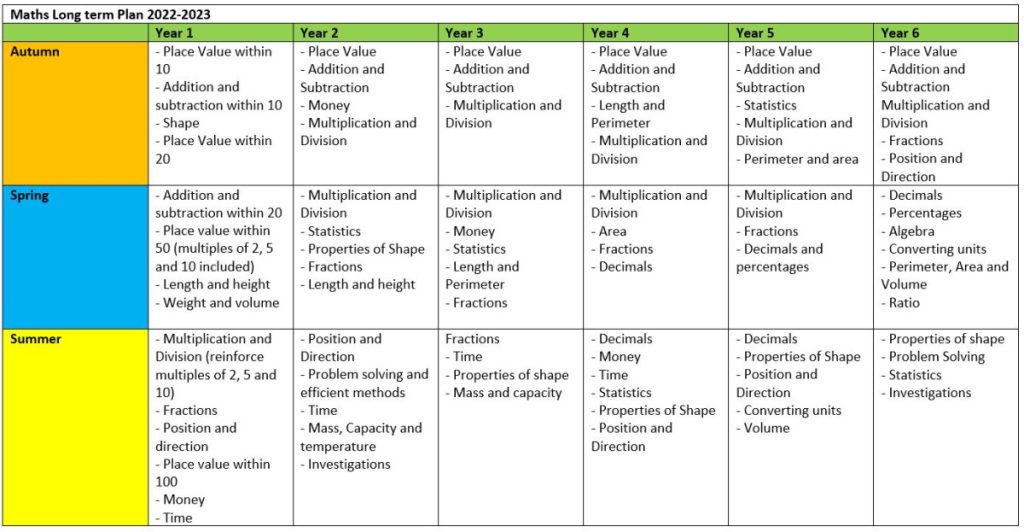Maths
Intent
Our intent is that all pupils:
· Have a positive attitude towards mathematics and an awareness of the fascination of mathematics;
· Become fluent in the fundamentals of mathematics so that they develop conceptual understanding and the ability to recall and apply knowledge rapidly and accurately.
· Can solve problems by applying their mathematics to a variety of problems with increasing sophistication, including unfamiliar contexts and real-life scenarios.
· Can reason mathematically by following a line of enquiry and develop and present a justification, argument or proof using mathematical language.
· Can use the language of mathematics accurately; discussing their learning with confidence and precision.
Implementation
A typical lesson involves KS1 and KS2 classes following the ‘White Rose Maths’ medium term plans and small steps guidance and examples; which use a spiral progression to develop fluency, reasoning, and problem solving and conceptual understanding for mastery. They focus on core topics to build deep understanding.
KS1 and KS2 :
· A dedicated maths lesson is taught every day. (approx. 1hr)
· The learning objective for the lesson is taken from the ‘White Rose Maths (WRM) small steps’ for that year group.
· The whole class are taught the same lesson objective. Equipment/resources will be provided to support pupils if necessary.
· During a typical lesson the children will have opportunity to practise skills taught (fluency) and move on to using these skills in reasoning and mastery activities.
· New concepts are taught initially using concrete examples, moving onto pictorial representations and finally abstract (See calculations policy).
· A greater emphasis on reasoning is given during lessons with children being expected to explain their strategies and workings using correct mathematical vocabulary. Stem sentences can be used to support the children (the sentence that is repeated throughout the lesson eg. The tenths sit on the right hand side of the decimal point.)
· One purpose of stem sentences is to highlight key points and remind children of important information.
· Partner work will be used during lessons. Children are encouraged to develop their reasoning skills by explaining to their partner the strategies they are using to solve a calculation or problem.
· Arithmetic challenges outside of the daily maths lesson are used to embed learning.
· Children will self-mark their work during the lesson and correct mistakes as they go.
· Children will use the red, orange and green pages in their planners to show if they need support.
Although this is a typical maths lesson, we know there are times when there needs to be flexibility within the lesson to meet the needs of groups or individual children, for example, mini plenaries throughout the lesson, additional mental and oral sessions, extended main activities, HA groups starting on mastery activities, etc.
Long-Term Plan

Impact
Monitoring Teaching and Learning
This will be undertaken by members of the SLT and the Maths leader. Results of any monitoring will be fed back to staff quickly and to SLT at their meetings so that any action required can be carried out effectively.
Assessment
This will be ongoing throughout the school year. Staff will use the end of year statements on ‘Target Tracker’ to record coverage and pupil progress; these should be updated throughout the term as topics are being covered. Pupils will be regularly tested to check their understanding of concepts taught. WRM end of block assessments are completed after each block of small steps and any gaps identified. WRM and Puma termly test are used to give an accurate indication of whether children are working at the expected level, and the progress they make during the year. Teachers are expected to input their pupils’ ‘level’ on Target Tracker every half-term and identify any vulnerable children who are not on track to meet Age Related Expectations (ARE) by the year end.
Marking
This should be in line with the school’s Marking and Feedback Policy. Where possible marking will take place during the lesson (teacher, self and peer) in order to identify children who are struggling and need extra support or reinforcement; and to move children on to reasoning and mastery activities (children will not be required to answer pages of calculations, 4 or 5 correctly completed is sufficient to show understanding). If not possible to mark during the lesson, then work will be marked, in most cases on the same day in order to inform planning for the next day.
Website links to support your child with Maths at home
